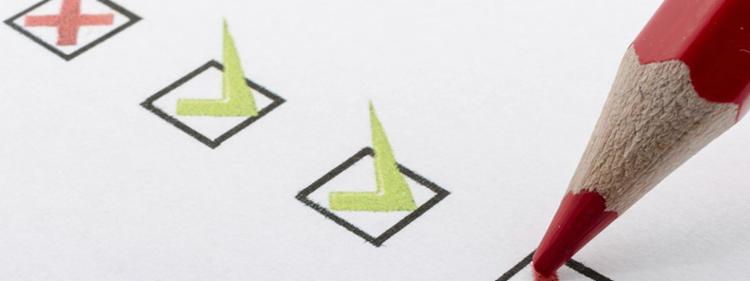A No-Brainer New Car Checklist for Every Buyer

The purchase of a new car is an important decision. You will be investing a lot of money into your ride, so it is important that you do not find yourself saddled with regret shortly after you drive it home. It is possible that you will overlook small, annoying features while you are still checking out the car in the showroom.
Thousands of new car owners have gone on to have buyer's remorse. We want you to be happy with your choice of car, so we have put together a new car checklist of things to look for before you sign a purchase agreement. But first, make sure you're covered with an affordable car insurance policy.
Checklist: New Car Exterior
Although it is true that you cannot judge a book by its cover, it is important that you be happy with the outward appearance and design of the car you are considering. Take a walk around the car and check out the following features:
- Color: This is a minor detail, but this is going to be your car for years to come. Do you like the color? Does it appeal to you? Does this car come in other colors that you like more?
- Overall appearance: Stand back and take a good look at the car. Will you be happy seeing it in your driveway? Are there things about its outward appearance that you do not care for? Can you live with these things?
- Trunk: How easy is it to open and close the trunk? What if you have your hands full with grocery bags or a heavy box? Is the trunk spacious? How many suitcases do you think would fit inside? Can you fold down the rear seat for extra space? If so, how easy is it to do this?
- Spare tire: Is the spare tire a standard tire or a donut? Where is it located? Is it is easy to access? Some new cars do not have a spare tire at all. Instead, they rely on “drive-flat” tires that enable you drive about 50 miles on a flat. If your prospective car uses these tires, be sure to ask how much replacement tires cost, as, according to Edmunds, they tend to be very expensive.
- Gas cap: This may seem like an insignificant detail, but for some people, the side of the car where the gas cap is located really matters. If you are used to it being on one side and the car you are considering has it on the other, how long will it take you to get used to this change? Also, does the gas cap lock? Must it be unlocked with a key or is there a mechanism inside the car?
- Doors: How easy is it to open, close, lock and unlock the doors? Do they feature an automatic locking mechanism? If so, is this something that may cause you to lock your keys in the car? If you are in a tight parking space, will the doors, if only partially open, still enable you to get in and out of the car? Do the rear doors allow for easy access to the interior? Will it be easy to help small children into and out of car seats?
- Running boards: Running boards can aid in the entry to vehicles that sit high off the ground. Is the vehicle you are considering equipped with running boards? Will they serve a useful purpose or merely cause you to dirty your pants legs in slushy or muddy conditions?
Checklist: New Car Interior
Get into your new car and look around. Do not limit yourself to sitting in the driver’s seat. Try out the passenger seat and the rear seats (if your car is equipped with them) as well.
- Ease of entry and exit: Is it easy to get into and out of the vehicle? Are you likely to bump your head on the trim? Do you need to hold onto something to get out? What if you will be driving elderly relatives around? Will they be able to enter and exit the vehicle easily?
- Layout of the dashboard: Take a good look at the vehicle’s dashboard. Are things located in places that are intuitive to you? How easy will it be to adjust the climate control or sound system while driving? Do you like the overall appearance of the gauges and control panel?
- Location of cup holders: This is something that many people overlook during a test drive. You are not likely to have a cup of coffee or a soda with you at the time. Be sure to check out where the cup holders are located. Are there enough cup holders to accommodate all passengers? Are they located in a position that allows for ease of access? If you have a cup in the cup holder, will it be blocking other things you may want to access?
- Space for electronics and other items: Does this car provide a convenient place for you to put your cellphone? What about your purse or other items you are likely to have with you?
- Glove box: Look inside the glove box. Is there enough room for items you are likely to keep in there? Is it lockable?
- Visibility: Are you able to see sufficiently in all directions? Is the rear window large enough to permit you to see what is happening behind you? Is the trim around the windows so thick that it inhibits you from seeing to the left or the right? Do you feel comfortable pulling out into traffic with the visibility afforded by this vehicle? According to AutoTrader, if the top of the steering wheel sits higher than your shoulders, it can interfere with your line of sight.
- Comfort: How comfortable are the seats? Is this car suitable for long distance drives? Is the driver’s seat fully adjustable? Are you able to adjust it in a way that is ideal for you? If there are other drivers in your household, will they also be able to adjust the driver’s seat in a way that works for them?
- Roominess: Does the car feel cramped or do you have sufficient head space and elbow room? What if you are wearing a heavy winter coat? Do you have enough passenger space for everyone you are likely to be driving around?
Checklist: New Car Performance
While taking your prospective new car on a test drive, be sure to pay particular attention to the following:
- How the car handles: Do you like how the car feels when you take it around bends and curves? Does the steering feel too heavy or too light? Do you feel that you are in full control of this car?
- Smoothness of the ride: How does the car feel when you take it over bumpy roads? Is the ride smooth enough? Is it too smooth?
- Cabin noise: Can you hear the tires from inside the cabin? Is it so loud that you need to raise your voice significantly when you speak? What about on the highways? Do the wind shear and engine sounds create a lot of noise in the cabin? Do you find the cabin noise acceptable?
- Braking system: Do you feel comfortable with the car’s ability to stop quickly with a minimal braking distance? Does it brake smoothly or do you tend to lurch the car when stopping? Is the emergency brake located in a place that is easy to access? Is the brake pedal located in a place that feels comfortable and intuitive to you?
- Ease of acceleration: How smoothly does the car accelerate from a stopped position? Does the car accelerate quickly enough to enable easy merges on the highway? Is the gas pedal located in a place that feels comfortable and intuitive to you?
Checklist: New Car Extra Features
The features listed below are usually optional add-on features, sometimes known as “informatics systems.” If you will be including any of these with the purchase of your car, be sure that they are easy to use and of a quality that meets your satisfaction:
- Sound system: Does the sound system feature all the media capability you are looking for? Are the speakers of good quality? Is it easy to adjust the bass and treble? Do you like the overall sound when using the system?
- Navigation system: You can opt to have your new car equipped with a built-in navigation system. If you are used to using a GPS, how does this car’s system compare to the unit you already have? Is it better? More intuitive? If not, you may want to forgo this feature and stick with your own system.
- Backup camera: Backup cameras allow you to check for objects or people who may be behind your car before you back up. They don't replace the need to turn in your seat as you do so. Does the camera in the car you are considering permit you to see what is behind you well? What if an object is very close to the rear of your car?
- Bluetooth capability: if you plan to include Bluetooth capability in the car you are buying, try connecting to it with your cellphone to see how it works? Does the sound come in clearly? Can people on the other end of the conversation hear you well?
Enjoy Your New Car
It is likely that the car you are considering may not meet your satisfaction in one or two areas of the new car checklist above. If so, ask yourself how important those features are to you. If they are problems that may cause you to regret your purchase, do not buy the car. There are hundreds of cars for sale at any given time. You may be able to find one that better meets your needs.
If you take out a loan on the car, your lender may require a certain amount of collision/comprehensive coverage before you hit the roads. Additionally, your state will likely require you to carry coverage for liability. When you need car insurance coverage, independent agents can help you get the right coverage at a cost that's often lower than the competition. That's because they work with several insurers, not just one. Independent agents can help.
